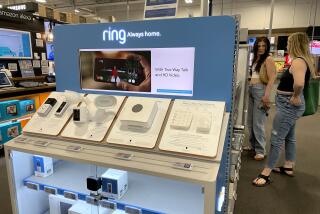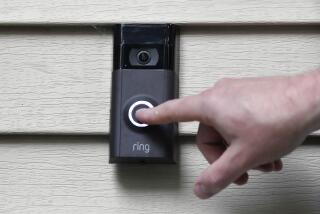New, Improved Versions of Gadgets You Know and Love
- Share via
Planning to line the bottom of your Christmas tree--or somebody else’s--with some new video equipment?
Here’s the good news: Don’t expect many new innovations this year.
Why is that good news? Because when new innovations hit the market just before Christmas, the gear that first appears offers little or no choice. A year later, though, a variety of brands and models adorn the store shelves.
Prime example: Super VHS.
The only Super-VHS VCR that many shoppers could find last Christmas was the first one out, JVC’s HR-S7000U, which, despite a high price, did not include any digital features (corrected in JVC’s upgraded S8000U model). This year there are several S-VHS decks to pick from, though prices haven’t gone down as many hoped they would--still hanging in the $1,000-$1,500 range for the most part.
The same thing applies to that tube you’ve got to run your VCR through: There’s a bandwagon of new, improved TV sets at your store this Christmas.
While VCR sales should be strong this winter (after a so-so year), many people are still going to avoid them, primarily because. . . .
--They’d rather opt for a video disc player instead. Laser discs are making a comeback, and there’s a whole new breed of players on the market that will handle all of the various digital-disc formats, including compact discs and CD-Videos.
--Or, they want to wait until the next big step in video comes along. That’s likely to be one of three things, or a combination of them:
Recordable videodiscs--meaning you can record over them just as you do now with video tape--are scheduled to arrive on the U.S. market between 1991 and 1993.
Fully digital VCRs--with digitally generated pictures (not just special effects)--are already in operation professionally, and these should come to the consumer market between 1992 and 1994.
And the revolutionary High-Definition TV system (HDTV) may come to VCRs and cable first, but probably not until the mid- or late ‘90s.
In no mood to wait?
Here’s what to look for in video equipment this Christmas. Here and there, we’ll even throw in some recommended models (based on a study of opinions by experts in the field who have closely examined and compared new models; Home Tech does not conduct its own equipment tests). Prices are retail--look for about 20% off at Los Angeles-area discount stores such as Adray’s, Circuit City and Rogersound Labs.
VCRs: Now is the time for all good people--rich ones, anyway--to switch to Super VHS. This improved format offers a noticeably sharper picture than standard VHS, including VHS with HQ circuitry. S-VHS VCRs will set you back $1,000 to $1,500, but most of them come loaded with other goodies, too, such as hi-fi stereo, MTS (stereo decoding) and digital special effects. Our picks: Mitsubishi HS-U80, the first S-VHS deck to come with a jog/shuttle wheel for editing, also features flying erase heads, outstanding digital effects and impressive design ($1,699); Instant Replay 771T58, an S-VHS machine that comes with just about every feature under the sun--including bar-code programming--and also plays non-American (PAL, NTSC and SECAM) videotape formats ($1,995).
Among the huge selection of excellent standard-VHS decks is RCA’s VR630HF, a midline ($699) model with hi-fi sound. For Beta enthusiasts, Sony’s ED-Beta system has received even better marks from the pros than Super-VHS. The Sony EDV-9500 model is the company’s star, featuring a jog/shuttle wheel and 500 lines of resolution, but it’s not cheap ($3,300).
TV sets: This area gave birth to the only really outstanding innovation that came to the market this year. Philips introduced its IDTV (improved-definition) system, which, using digital memory, doubles the 525 lines of resolution to a pretty close approximation of what 1,050 lines would look like--which means that you can hardly make out the scan lines at all. The system also contains circuits that defeat much video “noise” and blurring “motion lag.” Right now, IDTV comes in 27-inch ($1,500) and 31-inch ($2,600) sets.
Besides IDTV, television sets have improved enormously--mainly in terms of picture quality, digital features (the most useful being picture-in-picture) and sound-oriented features such as MTS decoding. If you have a Super-VHS VCR, be sure your new TV has S-connectors (also called Y/C separators) for interpreting the S-VHS signal.
Besides the Philips IDTV models, one of many good bets at the high end is the Panasonic Prism CTK-31905, which puts an incredible 640 lines of resolution on its 31-inch screen ($2,500). Meanwhile, 35-inch tube (or direct-view) models are available in many more brands and models than they were last year, as are rear-projection screens running up to 60 inches (that size is attained by the Mitsubishi VS-685R at a mere $4,299, or about $70 a diagonal inch).
Videodisc players: The apparent revival of this format is matched by an evolution in decks. The new models play everything from 3-inch CD singles to 12-inch Laserdiscs. There are several decks to choose from, but right now the one to get is Pioneer’s CLD-3030 ($1,300), because it’s the first such machine to offer the sort of freeze-frame and slow-motion effects on CLV Laserdiscs (the most common kind) that have been available previously only on CAV software. It also plays CDs and CD-Vs and has a jog/shuttle wheel--even on the remote control!
Camcorders: Shopping for a video camera is even tougher than it was a year ago. The two most competitive formats (VHS and 8-millimeter) are still going strong, and now there are also several Super-VHS models. On top of that, choosing VHS or Super VHS leads to another choice: compact (VHS-C or S-VHS-C) or full-size.
This is an area where you really need to get out and find which format suits your needs best. This year saw the “weight war” turn into a “lux war”--meaning that there’s less design concern with knocking ounces off camcorders and more with seeing who could come up with a model that can capture pictures in low light. Newer models also feature faster shutter speeds, power zoom, digital effects and even flying erase heads (great for smooth scene transitions, this feature had previously been available only on 8-millimeter models but now can be found on several others).
For the most adventurous, Toshiba also has developed a 3-D camcorder (SK-3D7 at $2,850), but reviews have been mixed.
Accessories: Want to add theater-like sound to your video viewing experience? How about one of the neat boxes that both decode surround-sound and let you play with the “audio ambiance” of your room? The trend this year seems to be toward audio/video amplifiers that combine these functions with others, including video enhancers and title generators, and also serve as useful multi-input/output stations. Two A/V winners: the Yamaha AVX-100U ($699) and the Pioneer VSX-9300S ($935).
These come with remote controls, as does just about everything else these days, which has led to a burgeoning market in single remotes that can be programmed to operate several pieces of gear. Even Radio Shack is in on this game, and its Realistic 100 model sells for $99.95.
Other goodies to consider: still video cameras (these new items take still photos electronically), video-effects generators, editing controllers, satellite dishes and receivers, speakers, Walkman-size TVs, video-game units . . . the list goes on and on.
Who said Christmas toys were only for kids?






